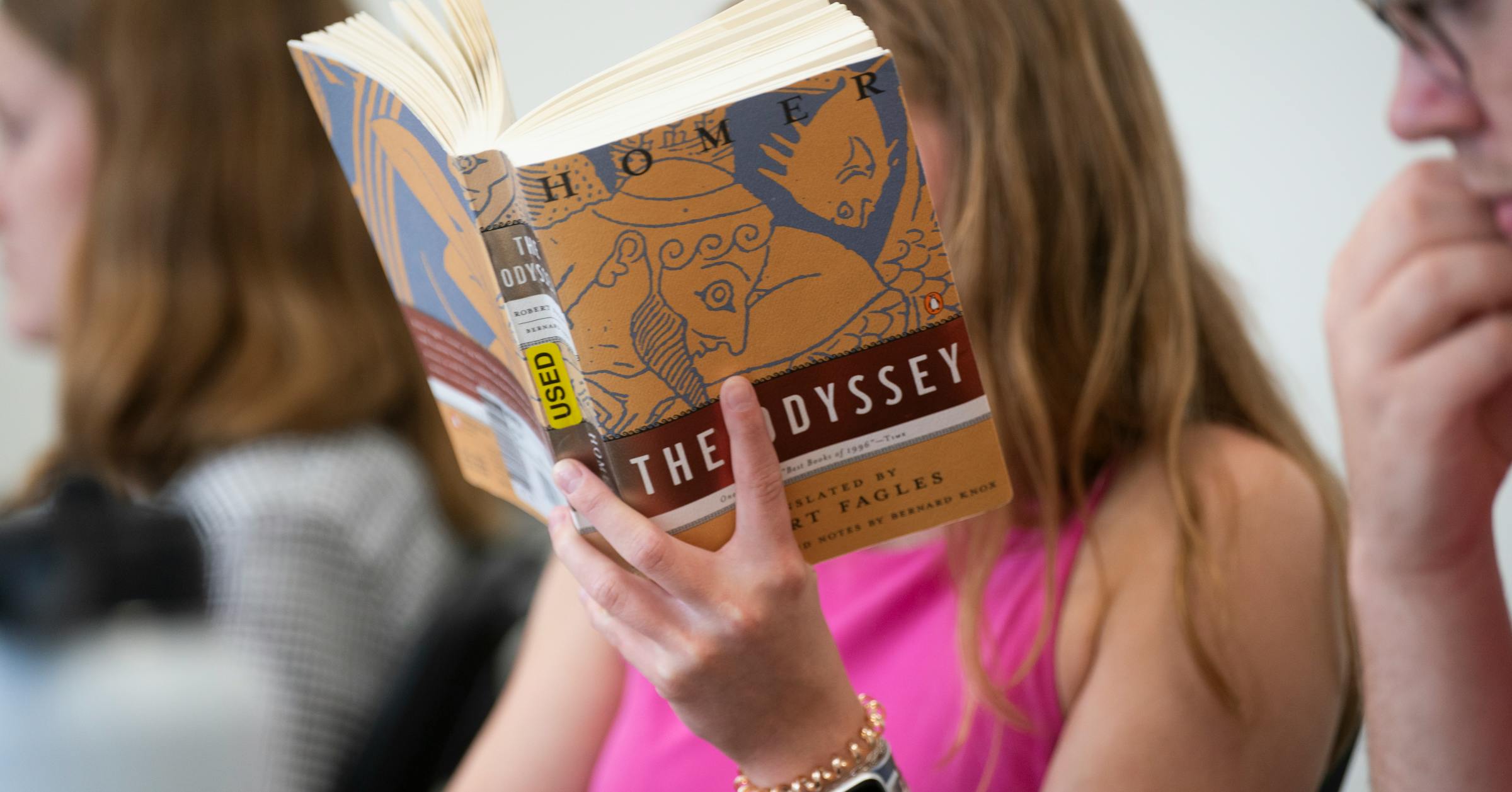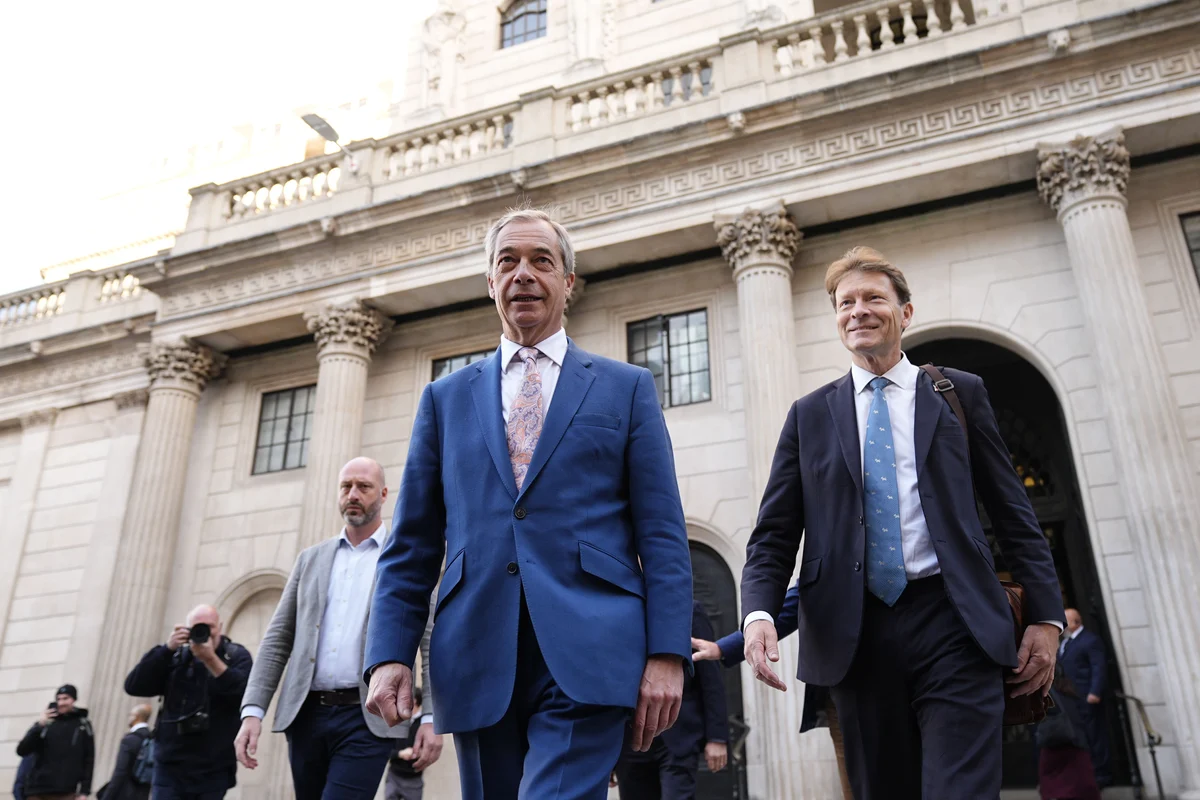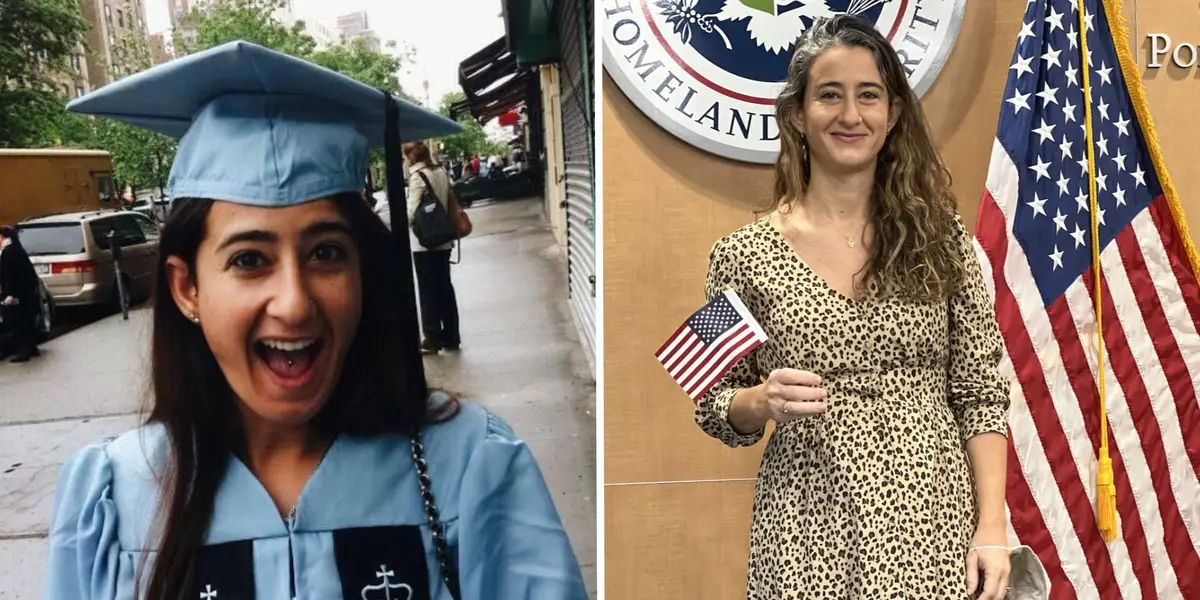
English majors in Minnesota have declined by 44% while health professions have increased sevenfold, for instance. What’s the future for the liberal arts?
By Erin Adler
The Minnesota Star Tribune
October 1, 2025 at 5:37PM
Emma Westrate holds up her book during a discussion of Homer’s “The Odyssey” during “The Ancient World and the Hebrew Scriptures” class in the Classical Christian honors program Sept. 23 in St. Paul. The University of Northwestern opened a Classical Christian Honors college this fall. (Renée Jones Schneider/The Minnesota Star Tribune)
The liberal arts, once considered a cornerstone of higher education, have been on a slow but dramatic decline at Minnesota colleges and universities for two decades.
English majors in Minnesota have declined by 44% while ethnic and gender studies majors have dropped by more than half over the last 18 years. Meanwhile, health professions majors have ballooned by 613% and computer science majors have nearly tripled.
“In the public’s perception, there is a real question around, ‘What’s the value of the liberal arts?’” said Ascan Koerner, a communications professor in the College of Liberal Arts at the University of Minnesota, Twin Cities. “I think there is such a concern about the return on investment of a college degree.”
The decreases in liberal arts degrees in Minnesota come as Americans reconsider what students should expect from a four-year degree as tuition costs and student debt keep climbing. And undergraduate students are choosing career-oriented majors they believe will make them more employable in a tight labor market.
Amid the long-term decline in liberal arts majors, though, officials are finding innovative ways to ensure the liberal arts remain relevant and integrated into students’ experiences. Schools are launching new classics programs, more students are adding a liberal arts-related double major or minor, and additional students are flocking to extracurricular activities like theater, officials said.
“People in my field are not simply giving up,” said Chris Gehrz, a history professor at Bethel University. “I think we are trying very hard to tell our story well, to understand where our students are coming from and to try to give them different kinds of experiences.”
Senior Natalee Bushman still believes in the value of a liberal arts degree. Bushman, a double major in English and communications skills at the College of St. Scholastica in Duluth, picked her English major because she loves to read, write and talk with people.
People often asked her what she was going to do with an English major, but that’s died down since she added communications, which is more transferrable to her future plans — attending graduate school next year for public policy.
“Shaping and crafting policies every day would be ideal for me,” she said. “I tell [people] like, ‘Oh, I want to work in government’ and they get that.”
Richard Robbins, director of choral activities at the University of Minnesota Duluth, leads a choral class in 2020. UMD’s School of Fine Arts merged with the College of Liberal Arts at the U’s Twin Cities campus in 2020. Students and faculty in different arts classes were affected during the merger. (Alex Kormann/The Minnesota Star Tribune)
Budget cuts
During the 2006-07 school year — the furthest Minnesota’s Office of Higher Education (OHE) data goes back — business, education and social sciences were the most popular majors. By 2023, business was still among the most popular majors, but so were health professions and psychology.
The COVID-19 pandemic makes it hard to interpret how students’ subject-matter interests are changing over time because some schools saw declining enrollment overall then. But statewide data still shows serious dips overall in liberal arts degrees since 2019. English degrees, for instance, have fallen 25% over that period, and political science is down 23%.
Related Coverage
Such numbers have led some liberal arts departments and majors to be put on the chopping block as colleges tightened their belts. St. Cloud State University cut five undergraduate majors, including philosophy and theater, in 2023 — the same year the College of St. Benedict and St. John’s University slashed majors like ancient Mediterranean studies and majors and minors in six world languages.
Three years ago, St. Mary’s University of Minnesota started phasing out 11 liberal art majors, including art, Spanish and theology.
Julian Klein and Mackenzie Court, center, discuss Homer’s “The Odyssey” during “The Ancient World and the Hebrew Scriptures” class in the University of Northwestern’s Classical Christian honors program. (Renée Jones Schneider/The Minnesota Star Tribune)
Administrators looked at which programs were sustainable financially and enrollment-wise, said Darren Row, vice president of academic affairs at St. Mary’s, adding that the university is still a liberal arts school.
There’s long been confusion about what the liberal arts are and those ideas vary widely, officials said, though most administrators say it includes a wide-ranging collection of disciplines, including fine arts, the humanities — such as English, philosophy and history — and the social sciences, like sociology. But liberal arts also encompass majors that have become more popular, including math and sciences such as biology. Psychology is also booming.
The “liberal arts” can often mean something different at liberal arts colleges, which focus on providing a broad, general education rather than career preparation alone.
That makes it hard to measure how the liberal arts are faring by just counting students’ majors.
“You’ll often hear ‘liberal arts’ and it’s not a group of majors necessarily,” said Susan Rundell Singer, president of St. Olaf College in Northfield. “It’s a way of learning, a way of knowing.”
Not everyone is seeing the same trends, though, and some colleges say the picture has gotten a bit rosier over the last five or six years, with big decreases leveling off and even a few gains. Liberal arts majors are up 8% at Metropolitan State University over last year, said College of Liberal Arts Dean Kristen Lillvis and programs like professional communication and studio art are growing.
The decline in liberal arts majors is often higher at large public universities than at liberal arts colleges, said Andrea Kaston Tange, an English professor at Macalester College, adding that English has hovered around the sixth-most popular major there for 10 years.
Even at such schools, though, students are increasingly drawn to the sciences, including at Carleton College, President Alison Byerly said. But students don’t choose Carleton if they’re not passionate about the liberal arts, she said, and the school has plenty of applicants.
Computer science is the most popular Carleton major, as it also was in 2015 and 2020. Biology and chemistry rounded out the top three last year.
State data shows history majors at Carleton and St. Olaf are down by nearly half since 2006-07 while philosophy majors are down by more than half at St. Olaf over the same period.
Willis Hall, the first building specifically built for Carleton College in Northfield, houses classrooms and departments for American studies, economics, educational studies, environmental studies and linguistics. (Jeff Wheeler/The Minnesota Star Tribune)
Trying new things
College leaders say that the liberal arts majors provide graduates with a long list of practical skills: critical thinking, communication skills, the ability to work well with others and adaptability among them. They also teach people to write persuasively, recognize patterns and pull together disparate information.
Across the state, administrators and professors said they’re finding new ways to ensure the liberal arts have staying power and remain relevant.
This year, Winona State University started its University Scholars Program, seven courses that meld the liberal arts with workplace skills, Provost Brenda Kowalewski said. One class combines English and computer science, with students working on digital storytelling projects. Another bridges history and public policy, she said.
“That’s one of those hopeful places where, if we’ve reached the end of the road for certain departmental and disciplinary possibilities … it doesn’t mean that it’s over,” said Joe Tadie, a theology and philosophy professor at St. Mary’s.
Many officials said they’re seeing more students double majoring or minoring in the liberal arts, too.
The number of English minors at Macalester has more than tripled in the last decade, Tange said.
“The idea that they can choose two things frees them up to choose something like a liberal art,” said Jason Lowrey, vice president of academic affairs at Bethany Lutheran College, adding that students can pursue their passion.
Julian Klein, a University of Northwestern student, is doing that, majoring in theater and intercultural communication with a business minor, adding the communications major because theater “is one of the least stable jobs you can get.”
People regularly ask him what he’s going to do for a job, he said.
Students leave their “Ancient World and the Hebrew Scriptures” class in the Classical Christian honors program at University of Northwestern in St. Paul. (Renée Jones Schneider/The Minnesota Star Tribune)
Jim Foster of the Minnesota Star Tribune contributed to this story.
about the writer
Erin Adler
Reporter
Erin Adler is a news reporter covering higher education in Minnesota. She previously covered south metro suburban news, K-12 education and Carver County for the Minnesota Star Tribune.
See More



